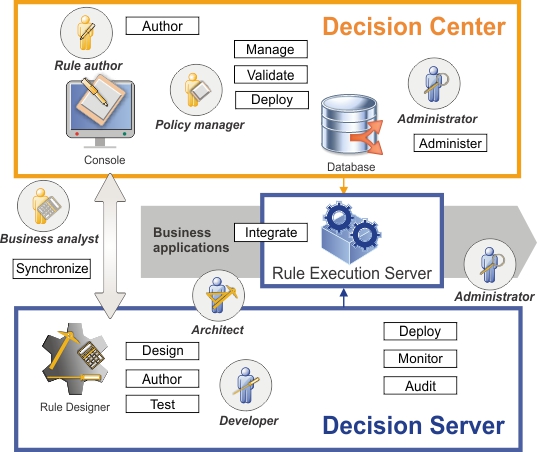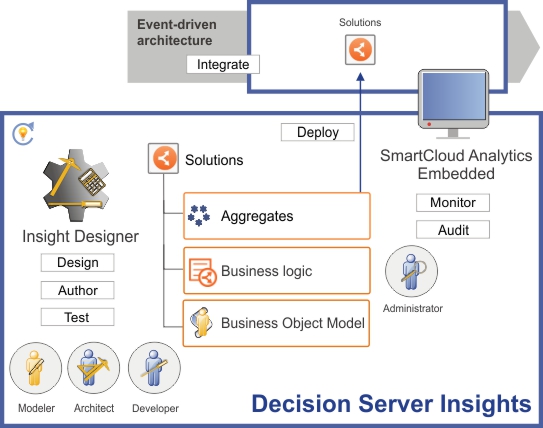Roles and activities
Operational Decision Manager comprises a set of modules that operate in different environments. Each step of the development lifecycle requires a specific set of skills and these activities can be divided into different users or roles. Roles within the team must be established early on in the development cycle.
Decision Server Rules and Decision Center
Decision Server Rules and Decision Center work together to provide a comprehensive decision management environment. The following figure shows the various activities that are involved and where each activity is carried out.

Two categories of users are involved in developing and maintaining a decision management solution:
- IT users
- Architects, developers, and administrators develop and maintain the rule application.
- Business users
- Business analysts, policy managers, and rule authors develop and maintain the decision logic.
The following table describes the different types of IT and business users that are involved in developing and maintaining a decision management solution.
| Role | Activities | Description |
|---|---|---|
Design Integrate Deploy |
Architects work mainly in Decision Server and have the following responsibilities:
|
|
Design Author Test Integrate Deploy |
Developers are familiar with object models, APIs, and the development environment (Java EE application servers, Java™ SE). They work mainly in Decision Server and have the following responsibilities:
|
|
Deploy Administer Monitor Audit |
System administrators work on the servers to ensure that they run smoothly. These servers can be for Decision Center or Decision Server. Administrators have the following responsibilities:
|
|
Design Author Test Synchronize Manage Validate |
Business analysts act as the bridge between business and IT departments, from design to integration inside a software application. They work in Decision Server and Decision Center. Business analysts have the following responsibilities:
Depending on their level of technical knowledge, business analysts can do tasks that are currently described as developer tasks. However, business analysts generally do not write code. |
|
Manage Validate Author |
Policy managers are the owners of the decisions within an organization and work mainly in Decision Center. Policy managers have the following responsibilities:
|
|
Author |
Rule authors work in Decision Center, and have the following responsibilities:
|
Decision Server Insights
Decision Server Insights comprises a set of tools to develop, deploy, and configure solutions in the runtime system. Each step of the lifecycle requires a specific set of skills and these activities can be divided into different users or roles.
The following figure shows the roles and activities that are involved in developing a solution.

| Role | Activities | Description |
|---|---|---|
Design Integrate Deploy |
Architects work mainly in Insight Designer to integrate configurations for the solution. They identify the incoming events that require updates to the entities of the solution, and the outgoing events the solution emits to the outside world. It is likely that the architect is a separate person to the solution developer, and does not have to know about the application's business logic. They are exclusively concerned with managing integration touch points. An example of an incoming event: A request from a Point of Transaction starts a sales transaction between a customer account and a merchant account. An example of an outgoing event: Notification to the Point of Transaction that the purchase is successfully applied. An architect maps external formats with the solution, and writes code to handle complex interactions with other applications and databases. Designers must find out what business dashboards are required to monitor the solution, so an architect can design and help to assemble these services for operations staff. |
|
Design Author Test Integrate Deploy |
A solution developer uses Insight Designer to construct a solution that includes entity models, event definitions, agent definitions, simple rule agents, aggregation and correlation rule agents, Java agents, and predictive model agents. The overall solution is the aggregation of all the developed projects in a set of deployable packages. A developer creates the agents that process the incoming events:
The process of developing a solution is iterative and includes the following examination:
|
|
Deploy Administer Monitor Audit |
The administrator role is to install, configure, and maintain all the tools that the development team plan to use. They do not always know how the tool is used, but they are often called when there are problems with the tool. In most cases, a lab is divided into different environments, which are likely to include a development environment, a staging environment, and a production environment. Before anything goes into production, it is installed in the staging environment to allow some time to pinpoint and fix any problems. The person in this role is expected to have an answer about what caused, or is causing, a tool problem. A system administrator keeps the IT infrastructure up and running. They constantly assess the requirements that are needed to support the evolving databases and applications. A database administrator ensures that the data processing needs are satisfied, and maintain the databases to ensure high availability and good performance. |
|
 |
Model |
Decision Server Insights solutions are systems of record in which data entities represent the primary objects of business interest, for example an Account or a Customer. These objects are updated by services that respond to events that carry information relevant to these entities. Entities are updated by policy (business rules) based actions or computations that are generated by analytics. A modeler must have a complete view of all the entities at the time of interaction to be able to identify risk and opportunity situations. An understanding of the past, present, and future business events is paramount to drive the appropriate and complete set of actions, or communications. The design of the business policy logic needs to be comprehensive and agile enough to remain responsive to business goals, regulatory initiatives, and changing circumstances. Ideally, the modeler can anticipate situations before they occur to maximize the value of early response. A modeler models the definitions that are required for the solution:
|